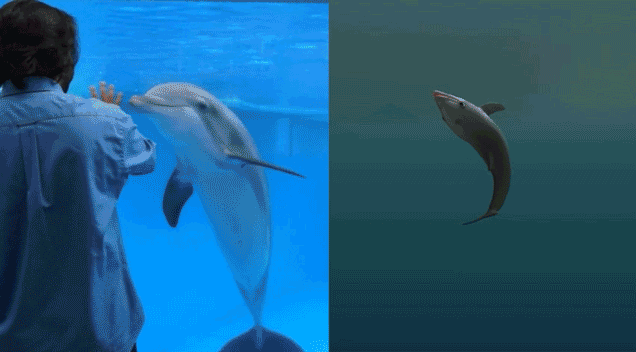Animal simulators are all the rage these days, with games about playing as goats, cats and bears all popping up in one form or another thanks to the magic of the internet.
Playing as various members of the animal kingdom isn’t all fun and games, however — though that’s certainly an essential part of any such experience. National Geographic just published an extensive profile of a group of researchers at John’s Hopkins University who are using a similar kind of animal simulator — this one focused on dolphins — for a remarkable therapeutic purpose.
John W. Krakauer, the director of JHU’s Brain, Learning, Animation, and Movement Lab (BLAM), and the rest of the team of programmers, scientists and animators, first created the virtual dolphin named Bandit as a new initiative to help treat patients recovering from strokes as they work to regain motor functions.
“Later this summer, in a series of clinical trials, post-stroke patients will get a chance to ‘be’ Bandit themselves,” National Geographic reports. “If the immersive, dynamic experience helps them recover lost motor function faster than the repetitive exercises of conventional treatment, it could signal a paradigm shift in rehabilitative therapy.”
The article gives a fascinating and often humorous breakdown of all the steps that were required to make this virtual dolphin a reality. The quest to bring out the “the idealised, essential ‘dolphin-ness’ of a dolphin’s movement” was more difficult than simply replicating the animal’s natural movements in a game, the team explains. Rather, they had to exaggerate certain motions and call in animal scientists to help emulate the “true emotional reality” of a dolphin’s life.
While all of this was originally designed for specifically therapeutic goals, Krakauer told National Geographic that he hopes the animal simulator will ultimately come out for mobile devices and help engender empathy for the plight of animals and spur interest in environmental causes.
“If you fool people into falling in love with animals for implicit reasons,” Krakauer said, “then you start finding out what you can do to protect [the animals]. For too long we’ve put the cart before the horse. People don’t need facts and data first. They need the things they love. And that’s movement — everyone loves to see something move beautifully, like a dolphin does in the water.”
This strikes me as the real value of all the animal simulators that are popping up these days: the encounter with a truly alien experience. Putting us in the shoes (or, more accurately, fins, hooves, and paws) of various virtual critters helps us see the real world from a number of unique perspectives.
Read the whole article here.
[via Alexis Madrigal]

Comments
2 responses to “The Dolphin Simulator Designed To Help Rehabilitate Stroke Patients”
http://www.kongregate.com/games/arawkins/dolphin-olympics-2
This is quite realistic and you can go to space.
Awesome stuff, good to see that gaming is moving into the rehab field – I know the team that brought us Fruit Ninja were/are working on a version that uses the XBOX Kinect to help people recover faster from debilitating injuries. And another team creating a program to help people with Alzheimers .